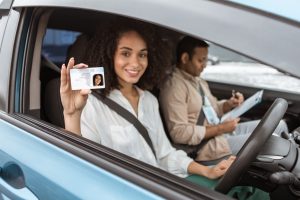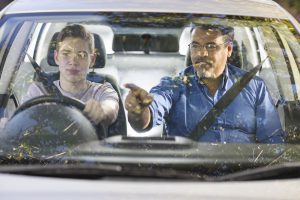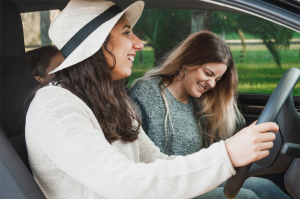The Ultimate Guide to Passing Your Practical Driving Test First Time
Getting your full driving licence is an exciting and life-changing experience. It gives you the freedom to drive where you want, when you want and what you want. You’re almost there … There’s only one thing that stands between you and the open road – the practical driving test. Read on for a run-through of everything you need to know before you book your driving test.
To help you more than double your chances of success in passing your driving test, we have put together this ultimate guide, featuring how the test works, what to expect and loads of truly amazing tips, tricks and hacks so when the big day comes, you get that first-time pass and finally get out on the roads on your own.
Did you know that the time of day you book your driving test can make a real difference in whether you pass?
Share with your friends … If you know other learner drivers, don’t forget to share this ultimate guide with them across your social media networks. Spread the word!
BEFORE YOU BOOK YOUR DRIVING TEST
The practical driving test is a challenging and daunting task on your road to independence, and unfortunately, there’s no magic spell that guarantees you’ll pass it the first time around. However, there are ways you can prepare that will improve your chances of passing your driving test on the very first try. Here are some helpful tips to ensure that you succeed.
Driving lessons with a good instructor and plenty of practice
The best way to learn to drive safely and confidently is to have professional tuition backed up by private practice. Driving lessons with an experienced, Approved Driving Instructor Potential Driving Instructor and plenty of practice between lessons with a relative or friend should prepare you for your practical test. Make the most of it. Gaining experience is one of the key ingredients of driving. With experience comes confidence. Spend as much time as you can behind the wheel, and don’t rush into taking the test until you’re ready. If you take it too soon, you will likely waste your time and money.
It’s important to remember that if you’re practising with your friends or family in their car, you need to make sure their car insurance policy covers you.
Who can teach you to drive?
Learn from a professional driving instructor.
When it comes to learning how to drive safely, you need a good foundation right from the beginning. If you’re learning to drive with a relative or friend (without a driving instructor), this may lead to them inadvertently passing bad driving habits (that they might have picked up over time) onto you and define the way you drive. Bad habits are hard to break.
To become a safe, focused and confident driver and pass your practical driving test for the first time, you need someone with the skills, knowledge and experience to teach you to the standard required for the test. And it’s unlikely that anyone other than a qualified Approved Driving Instructor (often referred to as ‘ADI’) would be better for the job. By having professional driving lessons with an experienced driving instructor, you can be sure they will be able to identify and correct any bad habits before they become entrenched – all in a calm and supportive atmosphere.
Choose the right driving instructor.
Finding a good driving instructor is not an easy thing to do. Finding an excellent one is even harder. Before you decide who you want to learn to drive with, do your research try to find the right driving instructor from recommendations, whether personal (from people you trust, such as your friends or relatives, who’ve recently passed their driving test) or check their social media page and website for feedback from previous learners.
Whichever driving instructor you choose to teach you this important life skill, make sure they are right for you. It needs to be someone you can trust and feel comfortable and safe with and who will prepare you thoroughly for every aspect of your driving test as well as for your driving life after you’ve passed. The best and safest way to learn is to find an experienced, skilled and professionally trained driving instructor who is approved and registered with the Driver and Vehicle Standards Agency (DVSA).
Practical driving test key links
- to book your driving test, click here
- to change your driving test, click here
- to cancel your driving test, click here
- to give yourself the best chance of passing your driving test, click here
- to give yourself the best chance to pass your theory test, click here
Practise with an experienced friend or family member.
Getting plenty of private practice between driving lessons is a great way to boost your skills and confidence behind the wheel and it gives you a better chance of passing your test. However, before you start private practice with a friend or relative, it is advisable to talk to your driving instructor to find out when you are safe and confident enough to practise in another car. Starting private practice too soon would be unsafe and could ruin your confidence behind the wheel.
Safety is paramount when learning to drive. It is important to remember that the person you practise your driving with must be over the age of 21, be qualified to drive the type of vehicle you’re learning in and have had their full driving licence for a minimum of 3 years.
Practise in different weather conditions.
You can’t predict what the weather is going to be like on the day of your practical driving test. It’s much different driving in the pouring rain than it is driving in clear weather, so ensure that you practise in all kinds of weather as often as possible. You need to prepare for any eventuality. This will give you valuable experience and will pay off hugely on the day of your test and after.
The more time you spend building a variety of skills in different road and weather conditions (at night, in rain, fog, and snow, and in heavy and light traffic), the more calm and confident you will feel and the better you’ll be able to react to challenging situations.
Keep track of your progress.
Whether you’re having lessons with an approved driving instructor, practising with friends or family, or both, it’s important to record and review your progress. This will help you better prepare for your driving test and become a safer driver. You will also be able to identify the skills that need more attention and practice.
To help you monitor your progress, you can use the Driver’s Record for Learner Drivers or, even better, consider fitting a telematics device (such as NDP Connect) in the car you’re using to learn to drive.
The device, which features a wide range of great services and benefits designed to support you as a driver every step of the way, will allow you to record each practice drive and review the feedback about it later. Following your progress will motivate you to keep working hard at becoming a better driver.
Determine when you learn best.
Everyone is different when it comes to learning to drive. Different people learn in different ways and at different paces. They also tend to learn better at different times of the day. Think about when your best time is and, if possible, try to align your driving lessons, private practice and the practical driving test to that period, when you have more concentration and focus.
Know the Highway Code
Many of the rules in the Highway Code are legal requirements for various road situations, knowing them will help you avoid serious faults. Understanding the rules and laws of the roads is fundamental to how you drive on the day of your practical test. Know your road signs, speed limits, lane markings and junction layouts and keep revising the Highway Code all the way through your lessons and before your driving test so you don’t display any of the MUST NOT rules or fail to show any of the MUST ones on the day of your test (and long after you’ve passed it, too). This will also help you feel more at ease during your test and make calm, precise decisions when under pressure.
Get your FREE copy of the Highway Code here
Practise with a Sat Nav.
Most learner drivers being examined for a licence will be asked to follow directions from a sat-nav RouteBuddy during the independent driving part of their test, so make sure you get used to driving using a sat-nav in your lessons. Have a sat nav in the car you’re preparing for your driving test in and learn how to follow its directions safely.
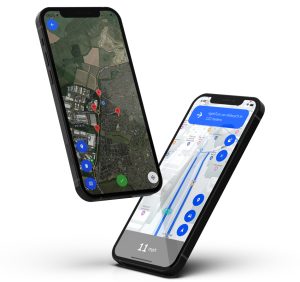
Wondering if we cover your test centre? RouteBuddy offers route previews for many local centres—check now to see if your test centre is included for practice.
When you’re following directions from a sat nav, you must remember that it’s not always 100% accurate. Don’t follow its instructions blindly. The device may have out-of-date or incomplete information at any given time. Make sure you pay attention to road signs, the road ahead and your surroundings at all times. Always be aware of changing road conditions and act on the basis of what is in front of you – not on what the sat nav tells you.
Remember, in the interest of safety and to reduce distractions while you are driving, you should always plan your route and set your destination before you set off. Never take your eyes off the road to adjust your sat nav whilst driving – it’s a huge distraction and could lead to an accident. If you need to plan a new destination or adjust your route, then make sure you pull over to a safe place first.
Driving Test Routes
It can be nerve-wracking driving in an area that you’re unfamiliar with and not knowing what to expect around the next turn, especially during your practical driving test, so make sure that you’ve done everything possible to get ready.
Preparation and knowledge of what areas and different types of roads, junctions and roundabouts you may be up against during your practical driving test can significantly increase your chances of success in passing the first time. So before you head out to take that important driving test, be sure to familiarise yourself with your chosen test centre routes and drive them as often as possible during your lessons with your instructor and when practising with friends or family. Knowing what to expect should help you to feel much more confident on the big day and help to soothe any last-minute nerves.
Online Driving Test Course that guarantees you will pass your driving test!
A truly exciting and innovative virtual learning platform designed to help you develop invaluable on-road driving skills off-road, prepare for your practical driving test and become a safe driver for life.
Click here to try it
Learn from your mistakes
Remember, making mistakes is part of learning. If your driving instructor points out an error or mistake during your lesson, make sure you fully understand it and work on it. Practise, practise and practise some more. If you don’t pass the first time, it’s extremely important that you address the mistakes you made in your test. This will give you a better chance of success in your next test.
Make clutch control your top priority
Do not put your name down for your practical driving test until you are absolutely confident about your clutch control. Without this fundamental skill, you may not completely control your car during your test.
Master your manoeuvres
If you dread the thought of (practical driving test) manoeuvres and the word itself strikes fear into your heart, there’s only one thing you can do to change it: PRACTICE. If you are struggling on a particular manoeuvre and feel like you will never master it, practise even more! Practise your manoeuvres thoroughly throughout your driving lessons and practice sessions until you get them right. You need to get confident at all of them before booking your test.
Know your routines
To stand a good chance of passing your practical driving test first time, you need to know your driving routines and use them every time you drive. It’s important not only to make your driving safer but it’s also crucial to pass the test. You should:
- Constantly check your mirrors (lack of appropriate observation is one of the most common reasons for failing a driving test)
- Always use the MSM (Mirror-Signal-Manoeuvre) driving routine whenever you change direction, approach junctions, roundabouts or traffic lights, or come to a stop
- Ensure that you use the POM (Prepare-Observe-Move) driving routine every time you intend to move off from a stationary position (either parked at the kerbside or when stopped at traffic lights, junctions and roundabouts, or in stationary traffic)
Failure to use the routines correctly can cause a dangerous or potentially dangerous situation on the road and will result in test failure. For example, your driving test examiner will score you a dangerous/serious fault if you change lanes without checking your mirrors or signalling causing danger to traffic behind.
Be aware of the speed limit
Speed limits are in place for a reason. They exist to keep the roads safe and avoid collisions. The risk of seriously injuring someone increases with your speed. Remember that driving even a few miles per hour over the speed limit could be the difference between life and death.
 The speed limit sets the absolute maximum speed for IDEAL conditions. But it doesn’t mean it’s safe to drive at this speed in all conditions. It’s a limit, not a target. Be conscious of the speed limit at all times, not only to pass your test (your use of speed and speed awareness) or avoid a speeding ticket but also to ensure safely reaching your destination. Driving safely is your responsibility – by speeding you’re putting yourself and other road users at risk.
The speed limit sets the absolute maximum speed for IDEAL conditions. But it doesn’t mean it’s safe to drive at this speed in all conditions. It’s a limit, not a target. Be conscious of the speed limit at all times, not only to pass your test (your use of speed and speed awareness) or avoid a speeding ticket but also to ensure safely reaching your destination. Driving safely is your responsibility – by speeding you’re putting yourself and other road users at risk.
You can learn more about speed limits here.
Speed Limiter
To help you stick to the speed limit at all times without having to constantly check your speedometer, you can use a speed limiter. It can either restrict your car’s speed to one you have chosen (an adjustable speed limiter, included as standard equipment on most cars) or automatically in response to speed limit signs. This allows you to maintain a safe speed and focus more of your attention on the road.
The adjustable speed limiter is set by the driver. You can select the maximum speed that you want to drive at and then continue driving normally. If you reach that speed, the car won’t go any faster, even if you continue to press the accelerator pedal gently. When you’re in traffic, the speed limiter will remain active as you slow down and speed up. If the speed limit changes, you will also need to adjust the limiter. If you need to speed up quickly, you can override the limiter by pressing down hard on the accelerator pedal.
Know your car inside and out
Each car drives a little differently so it’s a good idea to get to know the car that you’re going to take your practical driving test in. Whether it’s your driving instructor’s car, your own car or your family car, it’s important that you familiarise yourself with its controls and basic maintenance points before you take your test. This knowledge will be invaluable with addressing the initial ‘Show Me, Tell Me’ part of the test and will help you avoid scoring any unnecessary minors.
Wear the right footwear
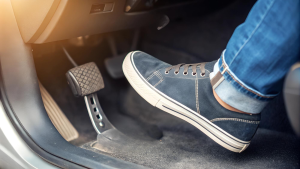 It’s essential to choose the right footwear for your driving lessons, private practice and practical driving test as certain types of shoes aren’t suitable for driving in. Wearing inappropriate shoes while driving can be dangerous as it makes it harder to control the car and may increase the likelihood of you having, or causing, accidents on the road. On the day of your test, wear comfortable and sensible pair of shoes, which are, ideally, flat with a thin sole and remain secure on your feet. This will allow you to get a better feeling for the pedals. You need to be able to feel the car respond to what you’re doing at all times.
It’s essential to choose the right footwear for your driving lessons, private practice and practical driving test as certain types of shoes aren’t suitable for driving in. Wearing inappropriate shoes while driving can be dangerous as it makes it harder to control the car and may increase the likelihood of you having, or causing, accidents on the road. On the day of your test, wear comfortable and sensible pair of shoes, which are, ideally, flat with a thin sole and remain secure on your feet. This will allow you to get a better feeling for the pedals. You need to be able to feel the car respond to what you’re doing at all times.
Take & pass a mock driving test
Preparation is key to passing your practical driving test at the first attempt. Taking and passing a mock driving test (or even several tests) with your driving instructor acting as the examiner is part of it. Think of it as a trial run. The purpose of this test is to assess how you drive under test conditions and whether you’re ready for the real one. It will also help to settle your nerves, putting your mind at ease in knowing what to expect on the big day, and will allow you to pick up on any areas of weakness in advance.
Practise real driving test routes with RouteBuddy at your test centre
Available on iOS and Android
It might sound obvious, but…
Don’t rush into taking your test until you’re ready. To become really good at something takes a lot of time, practice, patience and dedication. Learning to drive is no different. The knowledge, skills, judgement, behaviour, confidence and understanding necessary to drive a car safely take time and extensive practice to develop. So before you book your driving test, ask your driving instructor if you are test-ready. They’ve had plenty of pupils taking their driving tests and know what the test standard is. Trust their opinion. If your driving skills are not at the required level, there’s no point in taking the test. Think carefully before you book it. If you take it too soon, you’re more than likely to get disappointed. Taking the test before you’re ready is a waste of your time and money.
If you disagree with your driving instructor and feel you are ready and want to take the test against their advice, you can prove your ability to pass by taking a mock driving test. Ask your instructor to do a 40-minute lesson in the same format as the driving test. If you fail it, you’ll know the areas you need to work on before you head out to take the real test.
Avoid the usual mistakes
The DVSA (Driver and Vehicle Standards Agency) regularly publish the top 10 reasons why learners fail their practical test. To maximise your chances of passing your test at the first attempt, use your driving lessons to discover your bad habits and work on them.
Top ten reasons for failing in the year 2023/2024
- Junctions (observation)
- Mirrors (change direction)
- Control (steering)
- Junctions (turning right)
- Move off (safely)
- Positioning (normal driving)
- Move off (control)
- Response to signals (traffic lights)
- Reverse park (control)
- Response to signals (traffic signs)
BOOKING YOUR DRIVING TEST
How to book a driving test
You must pass your theory and hazard perception test before you can book your practical driving test. Do not rush into taking the test too quickly; before you book it, discuss the timings with your driving instructor to make sure you’re test-ready. Once your instructor has given you the green light to take your driving test, you can book it online with the Driver & Vehicle Standards Agency (DVSA) through the official GOV.UK page.
Book driving test
Before you click on the book your driving test link and start your booking process, prepare your UK driving licence number, credit or debit card and your driving instructor’s personal reference number if you want to check they’re available.
Remember, that if you intend to use your driving instructor’s car on the day of your test, you will need to book their time as well as the driving test.
Driving test cost
When you book your practical driving test directly with the official GOV.UK website, you only pay the cost of the test. There is no extra administration or booking fee. You might be charged more if you use an unofficial booking website.
The practical driving test for a learner car driver in the UK currently costs £62 on a weekday and £75 for weekday evenings, weekends and bank holidays.
Check your driving test appointment details
If you’ve lost or deleted the email with your booking confirmation, you can check your driving test appointment details here.
Change your driving test appointment
If after you’ve booked your driving test, you want to find an earlier appointment (sometimes called a ‘cancellation appointment’), move your driving test to a later date or change which test centre you take your test at, click here.
You must give at least three clear working days’ notice to change your test or you’ll have to pay again. Sundays and public holidays do not count as working days.
You can change your driving test appointment up to 6 times. If you need to make more changes after that, you have to cancel your test and rebook it. You’ll have to pay for the test when you book it again.
Cancel your driving test
If you no longer need your appointment, you can cancel your driving test here.
You must give at least three clear working days’ notice to get a full refund. Sundays and public holidays do not count as working days.
It might be beneficial for your driving instructor to do it for you
Driving Instructors can book and manage driving tests online for their pupils by clicking here.
Many Driving Schools like to book the test for you for two main reasons:
- They can swap tests between the students, so if you are ready sooner than expected or delayed for any reason, it’s much more flexible and therefore you don’t need to go to the back of the queue again.
- Some test centres have very similar names and the website is not the easiest to understand, so it stops tests being booked in the wrong place or date.
Book your driving test early
It’s very difficult for you and your driving instructor to judge when you will be ready to take your driving test, so if you book it early, you can always move it back. Once you book your driving test, you can log in online to the DVSA website and move your test to a later date.
If you want to get earlier dates, you can search the DVSA cancellation checker but may find it takes hours and hours before you find one, so we would recommend a driving test cancellation checker that will automatically check for cancellation for you at your requested driving test centre.
Best time to book your driving test
If you’re looking for all the help you can get to pass your practical driving test at your first attempt then best be careful what time of day you book it for. It can make a real difference to whether you pass! If you want to boost your chances, probably the best time of day to take your test is outside of rush hour. The last thing you want while taking your test is to be stuck in rush hour traffic with hundreds of other drivers under pressure to get somewhere.
Choose the right car for the test
You can take your practical driving test in any car you like, however, there are certain rules your car must meet in order for you to be able to use it for the test. Read about them here.
It’s important that during your driving test you do not use a car that you’re not familiar with. Controls can feel different in each vehicle (and getting used to a new car always takes time), so if you want to give yourself a better chance of success in passing your test, make sure you take it in the car you have regularly driven and are comfortable with. Taking the test in the car you know well will make you feel more confident about things like knowing where the biting point of the clutch is as this will allow you to move off and change gears smoothly. Good clutch control is key to passing your practical driving test.
Whose car should you use for your driving test?
Your Driving Instructor’s Car
This is the most frequent and ideal solution. Using the driving instructor’s car that you have been taking your lessons in since you started learning to drive means you know it well (this includes various reference markers used by your ADI for manoeuvres) and are very comfortable driving it. Additional benefit of using your driving instructor’s car during the practical test is that it should already meet the rules mentioned above and you don’t need to worry about insurance.
Your Parents’ Car
If you’re one of the many learner drivers who gained extra driving experience by practising in their parents’ car, you may want to use it for your driving test. Make sure the car meets the DVSA rules. If it doesn’t, your test will be cancelled.
It’s important to remember that if you’re having your practice lessons in your parents’ car, you need to make sure you’re covered on their car insurance policy.
Your Own Car
If you’re lucky enough to have your own car before passing your practical driving test, you are permitted to use it for the test provided it meets the requirements set out by the DVSA. Beware though because if your car doesn’t meet the rules, your test will be cancelled and you’ll have to pay again.
Chances are you’ll be driving this car once you’ve passed, so learning to drive in it will make you feel confident behind the wheel on the day of your test and after.
Remember that if you are learning to drive in your own car, it’s important to ensure that you have the right insurance policy. Once you pass your test, you will no longer be insured to drive your car with your provisional licence, so you will need to contact your car insurer to update your licence from provisional to full.
Book your driving test ANYWHERE in the UK
 Before you book your practical driving test, you need to understand that where you’re taking your practical driving test can have a big impact with UK Driving Test Centre Pass Rates differing hugely across the country. DVSA have released 2017’s driving test pass rates by test centre and the results are interesting! Did you know that depending on where you live in the UK, you may be at a serious disadvantage? Where you take the test can really make a difference. Obviously, you’re assessed in the same way, irrespective of where you take your driving test, but the routes you’re taken on will differ depending on the driving test centre. This can have a significant impact on how you perform during your driving test. If you live in a big city, you can more than double the chances of passing your driving test by changing your driving test centre. It’s obvious when you think about it – you are much more likely to make a mistake in a busy city than out in the much quieter and more predictable countryside.
Before you book your practical driving test, you need to understand that where you’re taking your practical driving test can have a big impact with UK Driving Test Centre Pass Rates differing hugely across the country. DVSA have released 2017’s driving test pass rates by test centre and the results are interesting! Did you know that depending on where you live in the UK, you may be at a serious disadvantage? Where you take the test can really make a difference. Obviously, you’re assessed in the same way, irrespective of where you take your driving test, but the routes you’re taken on will differ depending on the driving test centre. This can have a significant impact on how you perform during your driving test. If you live in a big city, you can more than double the chances of passing your driving test by changing your driving test centre. It’s obvious when you think about it – you are much more likely to make a mistake in a busy city than out in the much quieter and more predictable countryside.
Choose your test centre wisely
You can book your practical driving test anywhere in the UK so choose your test centre wisely. If you want to maximise your chances of success, take your driving test at a test centre with a high pass rate or a high first-time pass rate. You could practise in your local area to gain the skills and experience needed and when you feel you are ready, simply go on a short break to take your test up North. When you’re there, familiarise yourself with all the roads in and around your chosen test centre and you won’t have to stress about facing them for the first time on the day of your driving test. This will improve your confidence and reduce the chances of being caught out by an unfamiliar road layout.
TAKING YOUR PRACTICAL DRIVING TEST
It’s unlikely that you’ll manage to get through the day of your practical driving test completely stress-free (as it can actually be a nerve-wracking experience for most people) but whatever happens, don’t panic, you can do it. Remember your hard work and training and you’ll be in a strong position to pass your driving test first time round. During your test, you won’t be asked to do anything that you haven’t already done and experienced plenty of times before during the course of your driving lessons. The following suggestions and tips will help you know what to do and what to expect when you head out to take it, so you can prepare and feel more at ease on the big day.
Here’s what to expect on the test day
The practical driving test usually takes around 40 minutes and covers a variety of roads. The test breaks down into 5 parts:
EYESIGHT CHECK
The first thing you’ll be asked to do before you get in the car with the examiner is to read a number plate from a distance. This is to check whether your eyesight is good enough to be safe on the road before you start driving. If you fail to complete the task satisfactorily, the examiner will terminate the driving test and it will be marked as a fail. If you wear glasses or contact lenses, don’t forget to bring them with you.
‘SHOW ME, TELL ME’ VEHICLE SAFETY QUESTIONS
You’ll be required to answer two vehicle safety questions known as the ‘show me, tell me’ questions. The ‘tell me’ question will be asked at the start of your test, before you start driving and the ‘show me’ question – whilst you’re driving.
Failure to answer these questions correctly will count as a minor fault, so make sure that you properly revise them before your test.
GENERAL DRIVING ABILITY
To ensure you have excellent knowledge and understanding of driving, you’ll be assessed while driving in various road and traffic conditions (but not on motorways). During this part of the test, the examiner will give you directions for a route that you should follow. If you are unclear, ask them to repeat.
You’ll be asked to pull over and pull away. These may include normal stops at the side of the road, pulling out from behind a parked vehicle and a hill start. You might also be asked to carry out an emergency stop.
REVERSING YOUR VEHICLE
You will be asked to perform one of three possible reversing manoeuvres at some point during your driving test:
- parallel park at the side of the road
- park in a parking bay (either by driving in and reversing out, or reversing in and driving out)
- pull up on the right-hand side of the road, reverse for around 2 car lengths, and rejoin the traffic
INDEPENDENT DRIVING
To ensure you are able to follow road signs and road markings while demonstrating you can drive confidently and safely, you’ll have to drive without instruction for about 20 minutes by following either directions from a sat nav or traffic signs. The driving examiner will tell you which you have to follow.
The examiner will provide the sat nav (a TomTom Start 52) and set up a route for you. You’ll still be able to ask the examiner for confirmation of where you’re going if you’re not sure. Remember, the test isn’t about assessing your navigation abilities – it won’t matter if you go off the route unless you make a fault while doing it. You need to show you have sufficient skills to safely use a sat nav without getting distracted.
One in five driving tests won’t use a sat-nav. Instead, you’ll have to follow traffic signs.
What you need to pass
The practical driving test is an assessment of your ability to drive confidently and safely in all kinds of road and traffic conditions and your knowledge of the Highway Code. Your examiner will assess your driving according to 3 types of faults:
- a dangerous fault – this involves actual danger to you, the examiner, the public or property
- a serious fault – something potentially dangerous
- a driving fault – this isn’t potentially dangerous, but if you keep making the same fault, it could become a serious fault
The driving examiner will mark you on all aspects of your driving throughout the test. You’ll pass it if you make no more than 15 driving faults (often referred to as ‘minors’) and no serious or dangerous faults (‘majors’).
At the end of your test
Once you’ve returned to the test centre and safely parked, the examiner will let you know if you’ve passed or failed your driving test. Either way, they will go through your driving test report and provide you with feedback, including how many and what type of faults you made during your test. If you’ve failed, the examiner will explain to you what you’ve failed on and talk you through the reasons why. If you’ve passed, the driving examiner will give you a pass certificate and ask you if you’d like your full driving licence to be sent to you; if so, you’ll need to give them your provisional licence for them to send away for your full licence.
It’s important that you listen to the examiner’s feedback – even if you’ve passed – they’ll be pointing out the driving faults you made during your test. Being aware of the mistakes you make whilst driving will help you eliminate them and become a skilled, focused and responsible driver.
Driving test 2025: official DVSA guide
TIPS to help your test go as smoothly as possible
Now that you know what to expect on the day, here are some useful driving test tips to make passing your test easier.
 Get Your Beauty Sleep
Get Your Beauty Sleep
To increase the chances of you driving to the best of your ability on the day of your test, make sure you get plenty of sleep the night (or few) before and eat a good breakfast. You’ll feel more stressed if you’re tired. You need to be alert and attentive so you can react to the challenges on the road.
Feel confident
No matter how good people are at something, when the nerves kick in, they seem to forget everything they know and make silly mistakes. It’s perfectly normal to be nervous before your test, but if you’ve done your training and practised well and your driving instructor thinks you’re ready, then there’s really no reason for you to worry. Think happy thoughts. Picture yourself completing every driving test task successfully and achieving a first-time pass. Practising in your head and visualising every little detail before you take your test can make a tremendous difference as it can increase your confidence and comfort level.
The warm-up
To get yourself in the right frame of mind, have a final (double) driving lesson with your instructor just before your practical test appointment. The point of the lesson is to calm your nerves, get you comfortable and relaxed behind the wheel, have one last practice of the manoeuvers you find most difficult and discuss any last minute concerns.
Get to the Test Centre in good time
Don’t be late for your test. Arrange to arrive at the Test Centre about 15 minutes before your test is due. Driving examiners have busy schedules. Being late means you might have to rebook your test and you will lose your test fee. Have your documents ready for the driving examiner.
Keep your head in the game
Read up on the common errors during a practical driving test and make a mental note to avoid them. If you make a mistake during the course of your driving test, don’t panic, it will make things worse and may lead to additional errors and a failed test. Try to put it out of your mind and stay calm. Keep your eyes on the road and your mind focused on what’s going on around you. Take a deep breath, focus on the task at hand and listen to your examiner’s instructions. Make sure you look ahead and plan for what you see. You need to demonstrate that you are aware of your surroundings at all times and that you are able to control your car safely and respond to challenges on the road (including reacting to your own mistakes).
Don’t be afraid to ask
Make sure you speak up if, at any time during your driving test, you’re unsure or don’t understand what the examiner has asked you to do. Don’t be afraid to ask them to repeat or clarify their instruction. Don’t try and guess what they asked you to do as this could lead to you making an error.
When you pass your test
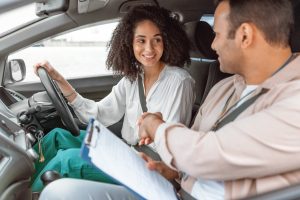 Congratulations! You’ve successfully passed your driving test! You’re finally free to drive without supervision! Wherever and whenever you want! You don’t need to wait for your full licence to arrive, your pass certificate will double as your driving licence until then. Remember to notify your car insurance provider that you are no longer a learner driver; you need to have an insurance policy that allows you to drive without supervision. Enjoy your freedom and stay safe.
Congratulations! You’ve successfully passed your driving test! You’re finally free to drive without supervision! Wherever and whenever you want! You don’t need to wait for your full licence to arrive, your pass certificate will double as your driving licence until then. Remember to notify your car insurance provider that you are no longer a learner driver; you need to have an insurance policy that allows you to drive without supervision. Enjoy your freedom and stay safe.
Celebrate!
If you don’t pass
Failing your driving test isn’t fun but don’t let your first time through get you down. It’s nothing to be ashamed of and you’re not alone. Official statistics say that only around half of all drivers pass their practical driving test the first time. Don’t compare yourself to other people. Everybody learns in different ways and at their own unique pace.
Get back behind the wheel
It’s disappointing that you won’t be able to get on the road straight away, but don’t get discouraged about your test result. The worst thing you can do after a fail is to let that one slip-up put you off. Think of it as a learning experience. The only way to get better at any skill is to practise it, so get back in the driver’s seat as quickly as you can and get in as much practice as possible. It’s the key to regaining your confidence. Head out on to the roads with your driving instructor, friends or relatives as soon as possible. Focus on the areas you need to improve, whatever you struggled with in the driving test. Practise your manoeuvres over and over again until you get them right. You’ll get there in no time.
Remember your driving test examiner’s words
It’s important that you take on board everything your driving examiner told you at the end of your test. Knowing where you went wrong is the key to success next time around, learn from it. Make sure you keep a copy of your driving test report, so that you can discuss the reason(s) for your fail with your driving instructor and see how they can help you work on your weak areas in the lead up to your second attempt.
Don’t stress out about your retest
OK, so you didn’t pass your practical driving test the first time and feel terrible about it – don’t give yourself a hard time because of it. Over half of learner drivers fail on their first attempt, for any number of reasons. Look on the bright side, now that you know what a practical driving test feels like, you’ll know exactly what to expect the next time. This should make you feel more confident and less nervous. It’s also worth remembering that those who pass their test at the second attempt are statistically more likely to be safer and better drivers once they qualify.
Re-book driving test
You will have to pay to book another driving test, so don’t go booking your retest straight afterwards if you think you’ll need a bit more time to prepare. If, however, you and your driving instructor think that the fail was down to a fault that can be sorted easily with a little more practice, consider rebooking your driving test as soon as possible.
Note that the date of the retest must be at least 10 working days after the last one. If you do book a retest and feel it’s too far off, use the official ‘change your driving test appointment’ page to see if you can find yourself a slot that has been cancelled at the last moment.
Use apps like RouteBuddy, which you can download to your phone or sat nav for real-world practice.
Other Helpful Resources: Change Your Driving Test and Driving Test Centre Pass Rates
Hopefully it won’t be long until you have successfully attained your full driving licence, and are finally free to enjoy driving unsupervised in your own car.
Good luck!


